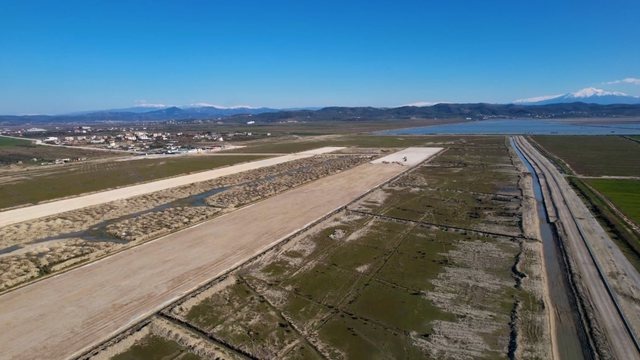
The introduction of a new airport and routes could alleviate strain on outdated buses, but at what expense to a precious wetland habitat for flamingos and other avian species?
Thick smoke emerges from the bus’s front as I endure a five-hour journey from Tirana to Sarandë. Without air-conditioning, a folded map provides some relief from another passenger. The possibility of an engine explosion looms, evident from the driver’s and passengers’ expressions of frustration.
For many visitors, this is the reality of travelling in Albania. Buses and car hire are the primary methods of transportation – so incidents like these are pretty regular. The only two cities accessible by international flights are Tirana and Kukës in the north, leaving mid and south Albania fairly inaccessible unless travelling by bus or car. However, Albanian transportation is shifting. Flight routes to Albania are increasing, and not everyone is happy about it.
The opening of Vlora International Airport is planned for April 2024, accompanied by Ryanair’s announcement of 17 new routes to Tirana, including flights from Stansted and Manchester. This move is anticipated to be well-received by the tourism sector, as the previous budget option to reach Tirana was via a bus from Montenegro. With Vlora airport offering direct flights to Albania’s coastal areas on the Adriatic Sea, it has the potential to stimulate development and boost tourism revenue. However, from a sustainability standpoint, several questions remain to be addressed.
Taulant Bino is a representative of the Albanian Ornithological Society, one of the two national NGOs involved in a lawsuit against the Albanian authorities concerning the airport construction. The organization’s primary goal is to safeguard areas of ecological significance and they have observed a recurring trend of state-owned protected regions, especially in coastal areas, being subject to exploitation.
The airport’s proximity to Narta lagoon, a renowned birdlife habitat and home to around 3,000 flamingos, has led to debates on whether it borders or encroaches upon it, depending on one’s viewpoint. Serious allegations have emerged, questioning the validity of the airport’s construction permit and whether works should have commenced at all.
“As an NGO, we don’t oppose airports in general. However, the Vlora airport project seems illogical from various angles,” says Bino. “It’s situated in a protected area, a wetland of vital importance, and an essential bird habitat.” He adds, “Furthermore, the Tirana airport is already nearby, making this new proposal even more nonsensical. Other alternatives should be explored.”
Annette Spangenberg, conservation head at Euronatur, a European nonprofit conservation foundation, echoes Bino’s worries and raises inquiries about the absence of a fast-train option connecting the existing Tirana airport, especially when Vlora and Tirana’s airports are merely two hours apart by car.
The project’s main advocate and driving force is Prime Minister Edi Rama, who has expressed strong support, anticipating significant tourism expansion with the new airport. Vlora airport is envisioned to accommodate direct flights from various parts of the world, potentially generating thousands of jobs, lowering fare prices, and transforming it into the primary tourist entry point for the region.



